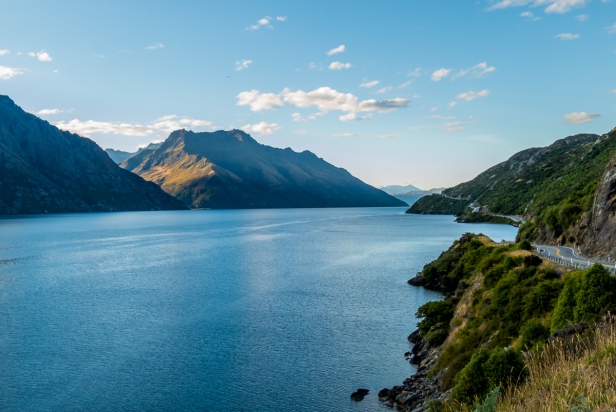
26 Feb-1 Mar 2015. We are standing in near total darkness on a metal platform inside a cave inside a mountain. A huge volume of water is thundering and roaring below us. There is just enough lighting to see the water. We are waiting to board a small flat-bottomed boat at the edge of a hidden grotto formed by a plateau that temporarily slows the onward relentless rushing of the water.
The water begins its journey from Lake Orbel high above in the Murchison Mountains in New Zealand’s Fiordland National Park. At the end of the lake the water goes underground as a river, eroding the limestone as it rushes down. Over many thousands of years the water has created a cave seven kilometers long. It is a perpetually expanding twisting network of passages filled with whirlpools and waterfalls. Having walked for a while along metal walkways we are only a short way into the cave although we are long past the point where any daylight penetrates.
One by one we climb carefully into the boat. And then all the lights go out. Pitch black is not an exaggeration. Impenetrable darkness. Slowly and silently the boat moves forward and looking up we see the lights. We are in a wonderland where, in the blackness, we see stars as in the darkest night sky; only they are close, so close I feel I can almost touch them. There are hundreds of them. Hundreds. Everywhere we look. The boat glides back and forth. I sit in amazed silence. Everyone is silent. Darkness. Silence. Magic fairy lights.
All too soon it is over and we return to the docking platform and make our way out of the cave. The secret of the silent boat moving against the current is overhead pulleys. The secret of the lights? They are glowworms, and I learned a thing or two about them. Insects are washed down from above as lava. They get caught on the walls of the cave and eventually hatch. They are attracted to the only light available: the light from the glowworms, and the hungrier the worms the brighter they glow. The glowworms create toxic dangling silk threads about two or three inches long. The insects get stuck in the threads and become dinner for the worms. Apart from eating insects they are also territorial cannibals. If a young worm makes its home too near another it will be eaten in a flash.
Earlier on this glorious sunny day and we had taken a walk around the shores of Lake Te Anau,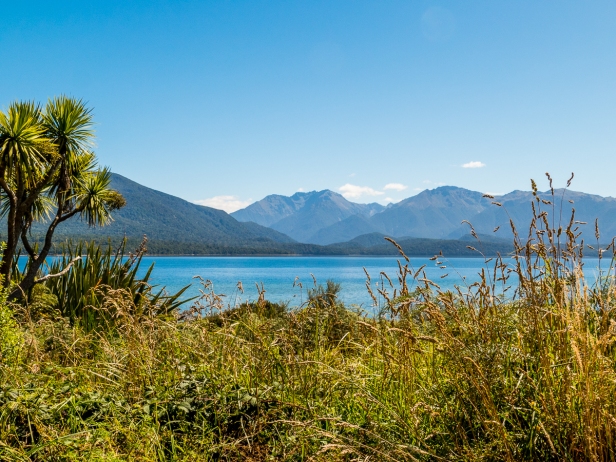
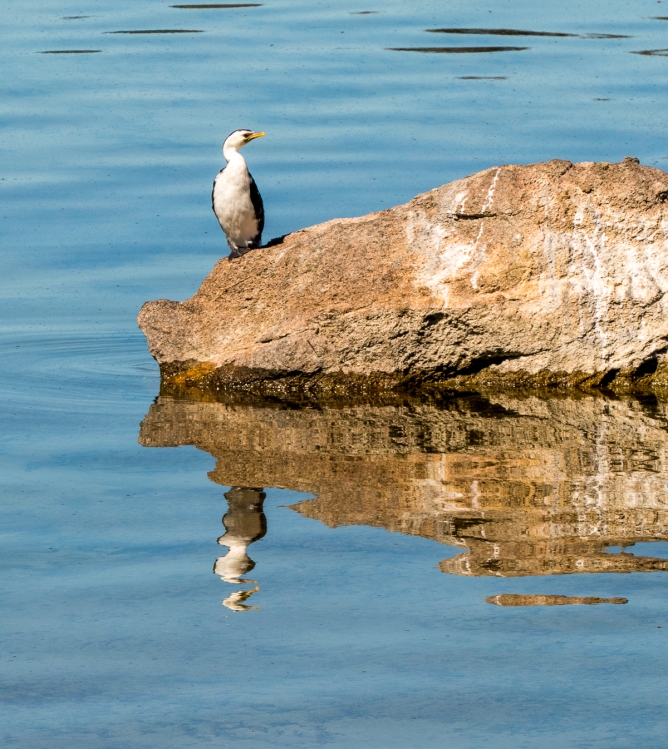
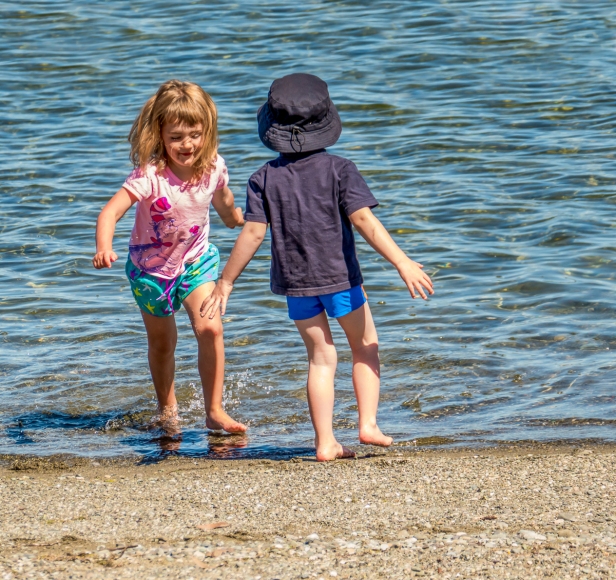
and followed it with a cruise on the lake that included the visit to the glowworm caves.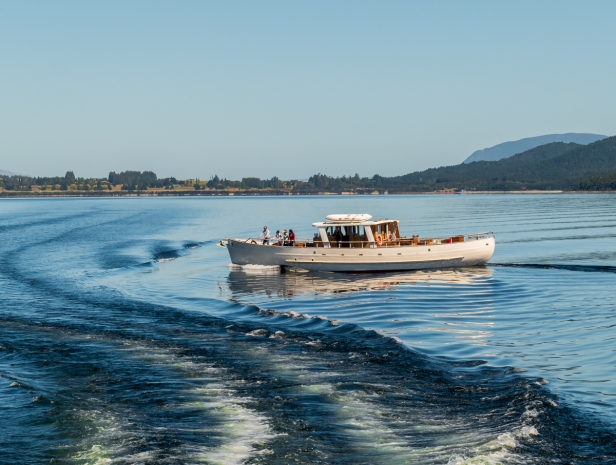
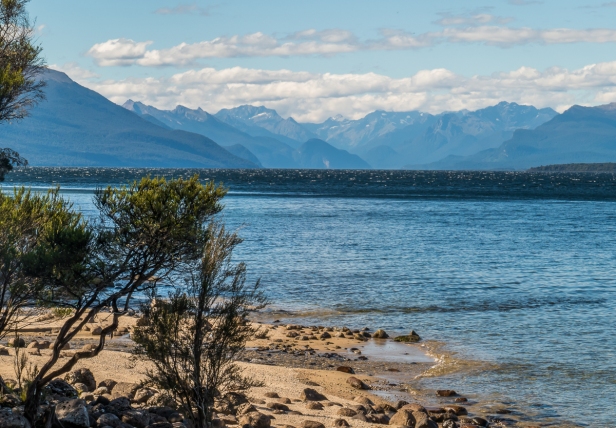
Lake Te Anau is a short drive from Queenstown where we were staying, and which is located in an equally spectacular setting. In Queenstown we were overwhelmed by youth on a quest for extreme adventure. The hostel in Queenstown was where a couple of older people remarked, as they saw us, “Oh look, some other people over twenty!” Every kind of thrill imaginable is available in Queenstown: bungy jumping, sky diving, canyon swinging, white water rafting, jet boating, river surfing, zip-lining, cross-country quad-biking, paragliding, hang gliding, and canyoning. We called it Adrenaline Central, and stuck to walks and cruises, though I swear I will go sky-diving one day. Tandem of course. Don did it solo many years ago and swears he will never do it again.
From Queenstown we drove southeast to Dunedin. It was a pleasant drive through green rolling hills with none of the compelling insistent beauty of the mountainous country around Queenstown and Fiordland National Park. Lots of sheep though.
We’d found accommodation in Dunedin for four days at Hogwartz Hostel and knew we’d need the time there to do some forward planning. At Hogwartz the cost of Internet data was an eye-watering $50 per gigabyte so we spent one of those four days in the local library, where we could get free Wi-Fi, planned an itinerary for the South Island, and booked accommodation for the coming couple of weeks.
Dunedin seemed like a charming city, what little we saw of it. There are many lovely buildings,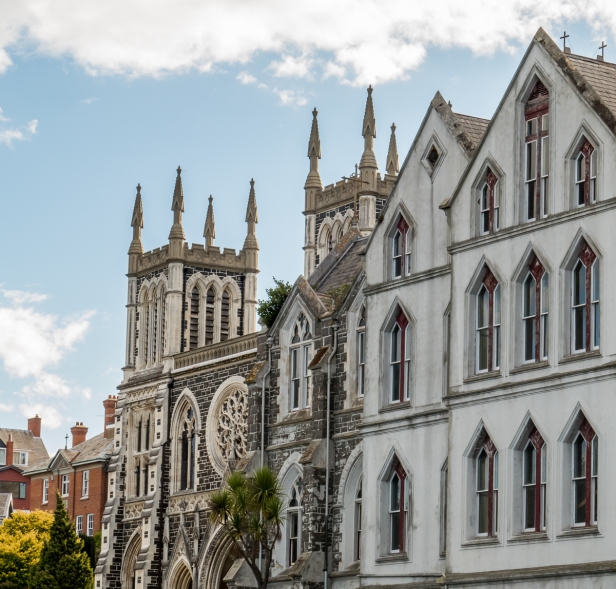

and an imposing railway station, that embodies Dunedin’s wealthy heritage and is New Zealand’s most photographed building. I was compelled to add to that statistic, though not of the outside which didn’t appeal to me, but of the beautiful interior. If you’re curious about the exterior you’ll find a picture easily enough on the web, and you can also see it at the bottom of the street in the photo above. The use of contrasting dark and light limestone and the intricate decoration led to the architect, George Troup, being given the nickname “Gingerbread George”.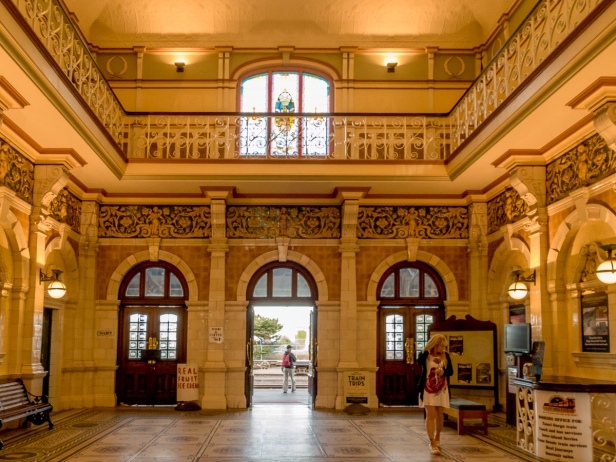

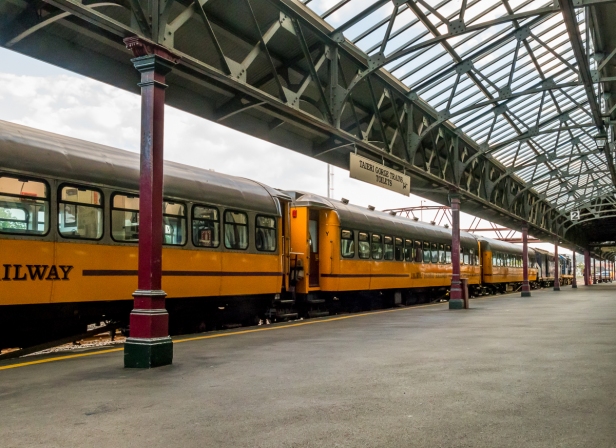
On the coast north of Dunedin, marooned at Koekohe Beach, are more than fifty huge fantastical boulders, some as big as three metres in diameter. They’ve been called variously hooligans gob-stoppers, aliens brains, and the bowling balls of giants. They are lumps of sediment bound together by mineral cement that took four million years to grow in a pile of mud about sixty million years ago. Eventually they were exposed by erosion and rolled down to the sea. And there they sit, ancient motionless marbles, the plaything of tourists.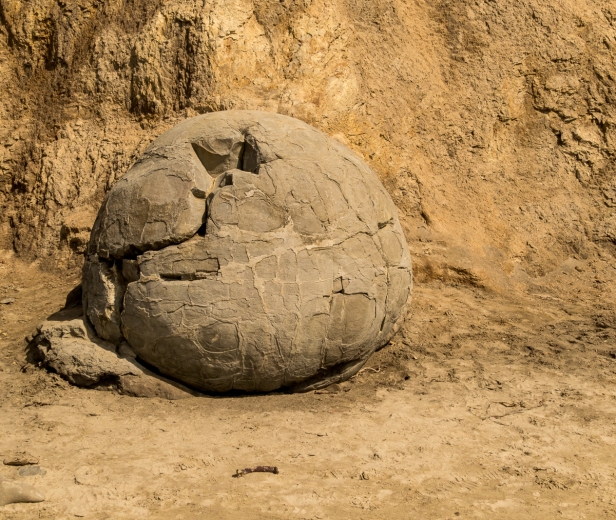
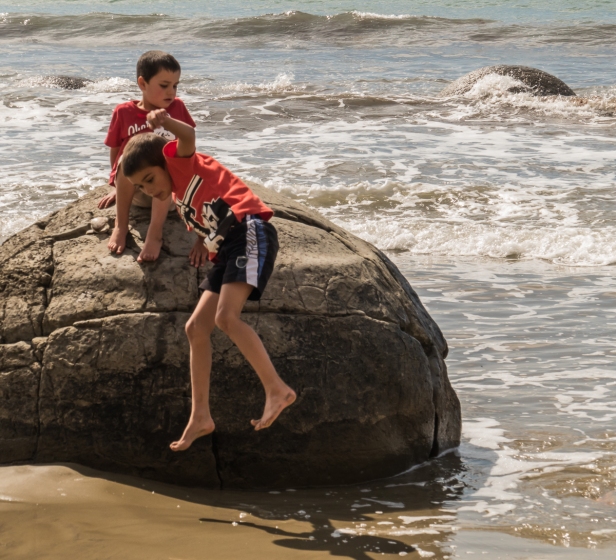
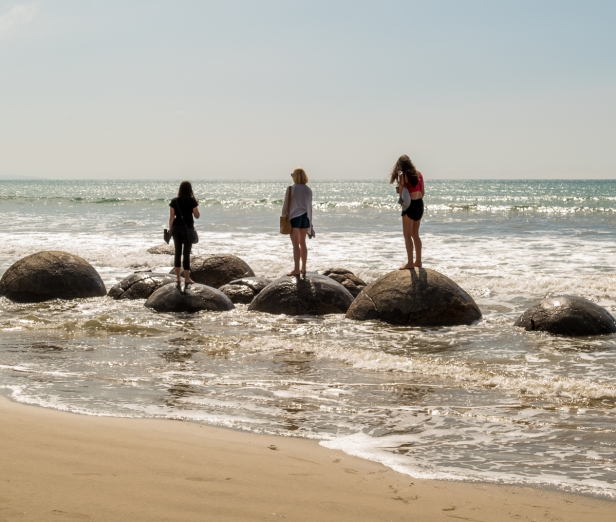
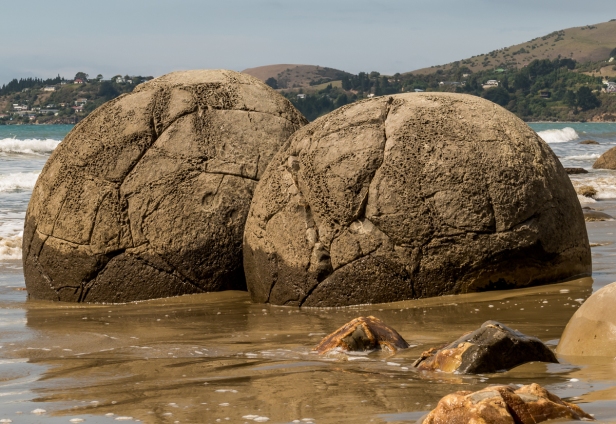
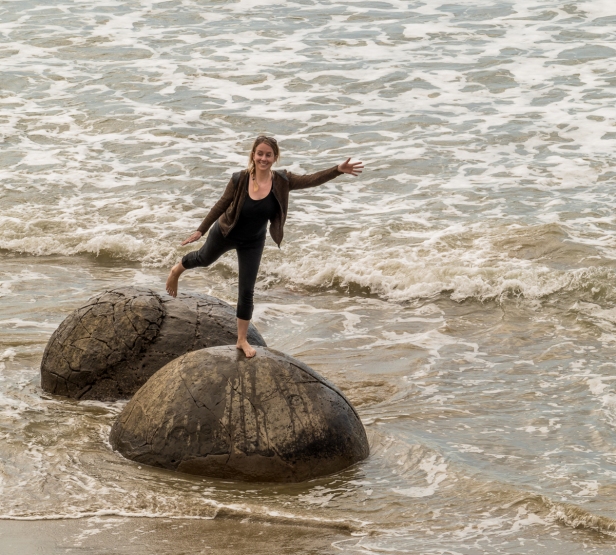

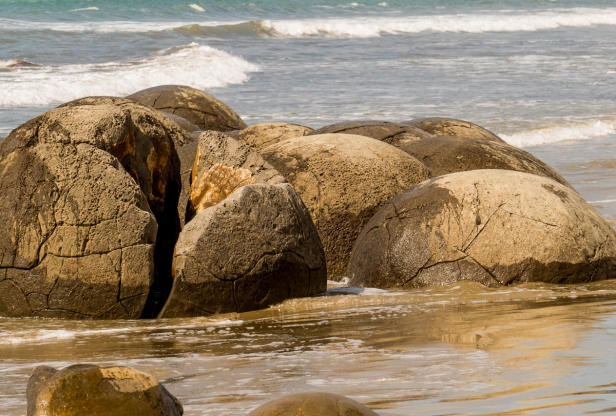

The boulders were fun, and fascinating, but I was as much taken with the tangled beauty of the beach debris of shells, driftwood, and unusual brilliant pink seaweeds.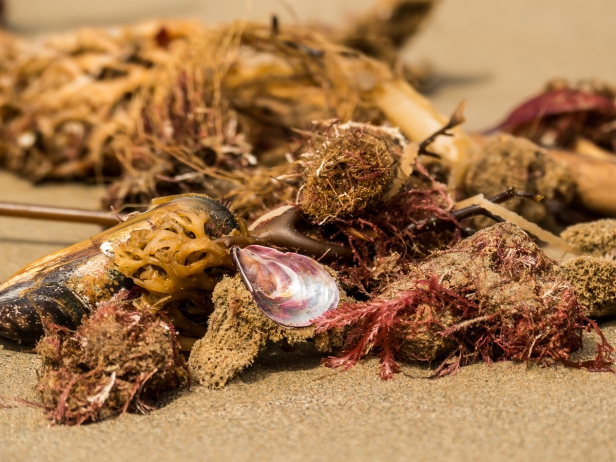


In the next post: a nature-lovers paradise at Otago Peninsula, albatross and yellow-eyed penguins, and Mt Aspiring National Park.
All words and images by Alison Louise Armstrong unless otherwise noted
© Alison Louise Armstrong and Adventures in Wonderland – a pilgrimage of the heart, 2010-2015.

Super post as usual. Anyone else see the seaweed in one of the pics looks like the head of a sea otter on a broken collar and leash?
LOVE the marbles and the glowworm story.
K
LikeLike
Thanks Keith. I couldn’t see the sea otter but Don spotted it. He says you have a vivid imagination 🙂
Alison
LikeLike
The cannibal grotto sounds absolutely incredible. I can’t say I share your enthusiasm to go sky-diving, but I do love the marbles and the ocean pictures. 🙂
LikeLike
Thanks Felicity. Yes, the glowworms were something special. Apparently they can be found in several places in NZ as we saw tours advertised in other places. The marbles of Moeraki are so unique, but not totally – apparently something similar exists in other places too. I really loved them, but also loved the bright pink seaweed – never seen anything like that.
Alison
LikeLike
Another splendid tour with so much sightseeing. Lovely.
LikeLike
Thanks so much Tish, glad you enjoyed the tour 🙂
Alison
LikeLike
My little holiday for the day,
thank you to take me with you
into the cave and once more
to the beach 🙂
Be healthy and hug ❤
LikeLike
We are so happy to have you along
Glad you enjoyed this little holiday
Health and hugs to you too.
Alison
LikeLiked by 1 person
So beautiful! We would love to visit New Zealand, and I’m now going to look specifically for the glowworm caves!! Sounds enchanting. And the boulders look like great fun- love your photos of the kids enjoying them.
LikeLike
Thanks so much. Do visit New Zealand. It’s really quite special. I think the glowworms are unique to NZ but they can be found in several different places there. We have no idea if we chose the best place to see them or not, but what we saw was really magical.
Alison
LikeLike
That’s it, Alison and Don. We’re just going to have to follow in your footsteps and go and see it for ourselves. I was in raptures reading about the glow worm caves. Thank you as always for a beautiful story.
LikeLike
Thanks Ros, glad you enjoyed it. Yes, you must go to NZ. It’s beautiful!
Alison
LikeLike
WOW! So gorgeous and riveting commentary~
LikeLike
Thank you so much Cindy for your wonderful compliment. New Zealand is definitely one beautiful place that’s for sure.
Alison
LikeLike
Love your travels. Of course, I was a bit curious when I kept reading your title as ‘cannibis worms’ 🙂
LikeLike
Thanks Marsha. Cannibis worms lol! That would be something to see! And no wonder you were intrigued 🙂
Alison
LikeLiked by 1 person
Your glowworm excursion sounds more awe-inspiring than ours. We walked deep into a cave and there they were – somewhere near Franz Josef Glacier, I think. I still get the shivers thinking about that dank, dark cave! Did you get to the Dart River area at all? Or am I being impatient?!
LikeLike
The glowworm experience really was magical. By the sound of yours I’m glad we chose the one we did. No, we didn’t get to the Dart River area. From Dunedin we went to Wanaka and Mt Aspiring.
Alison
LikeLike
What a magical cave. What kind of camera do you use? I am rather confused about what kind to get for myself, and the time has come for me to decide. thanks!
LikeLike
Yes, it really was magical. I have a Panasonic DMC-FZ1000. It’s a bit bulky and a bit heavy but it has a built in 25-400 zoom which is great. Overall I like it for what it is. It’s not my ideal camera which would cost a mint and the lenses even more, but a girl can dream 🙂
For something better than a point and shoot I’d definitely recommend it, but it will never give the quality of a camera with a full size sensor.
Alison
LikeLike
Dunedin is supposed to have some great Art Deco buildings – did you see any of them?
LikeLike
Um, I can’t remember. I believe there may have been one or two. Napier is the Art Deco town and we didn’t get there.
Alison
LikeLiked by 1 person
My take on the gobstoppers: golf is an older game than we think, and there was indeed a time when giants walked the land. You can always find piles of golf balls in the water hazards, which of course the Planet Earth is one. You can see the tee boxes on the moon where all the divots were never repaired. From there, it takes a pretty good seven iron to hit New Zealand and not roll off the far side down into the water…
I guess the concept of glow worms attracting food into pitch blackness kind of suggested we throw out a few conventions and dream big. And I loved the inside architecture of that station. Your photography is justice-bestowing on all it sees, as usual…
Michael
LikeLike
I love your take on the boulders 🙂
Of course that’s what they are!
Glow worms are a miracle of nature – talk about dreaming big. Throw a bunch of little wrigglies into darkness and figure out a way fro them to survive. Brilliant!
For me the railway station was all about that beautiful room. Thank you for your lovely compliment.
Alison
LikeLiked by 1 person
Those boulders are incredible. I wonder if they only occur in New Zealand, but if so, I wouldn’t be surprised. This country is so full of beauty and mysteries found nowhere else, so why wouldn’t they have boulders that took four million years to grow in a pile of mud sixty million years ago! Thanks for another blog post that made me stop and think, and reflect and simply feel in awe.
LikeLike
Thank you so much Helga. I’m glad you enjoyed the post. New Zealand is a definitely a land of mysteries, but I must let you know the same (or very similar) boulders occur on the northern coast of California, and quite possibly elsewhere that I don’t know about.
Alison
LikeLike
Your account of the glowworm cave is especially absorbing. ❤ I would love to go skydiving too, someday.
LikeLike
Thanks SGMT, I’m glad you enjoyed it. Yeah, skydiving – one day . . . . . . . .
Alison
LikeLike
Glowworm is probably one of the most fascinating creatures on the planet, for its glowing thread and the total darkness it lives in. James also told me about the magical sight when he saw the worms in New Zealand many years ago. Lake Te Anau itself looks spellbinding; I imagine myself walking down the lake banks and taking lots of photos. Gorgeous captures, Alison!
LikeLike
Thanks Bama. I discovered that the glowworms in NZ are different from those in North America. In NZ they actually are the larva stage of an insect, and carnivorous as I already pointed out. But who needs the details – it was such a beautiful other-worldly experience to see them while floating in a small lake in that pitch dark cave. As for Lake Te Anau – we did walk around the banks – beautiful! I have *dozens* of pictures 🙂
Alison
LikeLike
My grown children still talk about the glow worms they saw in New Zealand 30 years ago.
LikeLike
I’m not surprised – it was a pretty special experience.
Alison
LikeLike
Your account of the glow worm cave was captivating but sounds frightful as well–for the claustrophobic. – Ginette
LikeLike
Thanks so much Ginette. The glowworm experience was fabulous, but yes, not so much fun for the claustrophobic.
Alison
LikeLike
Leaving out the city, this post is a small piece of paradise 🙂 I had a similar (but I expect much smaller scale) experience, many years ago in the Caves of Drach in Majorca.
LikeLike
Yes, definitely paradise. We were constantly filled with the beauty of New Zealand. It is a quite special place. I’d love to get to Majorca one day.
Alison
LikeLiked by 1 person
Okay, it’s official: I am going to learn PS. And maybe buy a FZ1000. And maybe pay you to teach me PS. Funny about sky diving. I once took a class to learn, and learned how to fold the parachute, did the ground training. Then, one day I quit going to that class, never returned. Fear? Stupidity? Intelligence?
At the first photo of the giant balls, I was wishing you had stuck Don in the photo for size perspective. Then, as though wishes get answered on some blogs, you offered a couple with people. My next thought was that I wanted one of those balls for the garden I don’t have. My next thought was that maybe I’ll go to NZ for summer (their winter). Is it a bad time to go? Cold? Rainy? Snowy? Should I go to Hawaii instead?
LikeLike
Thanks 🙂
I also give thanks to my sisters who taught me LR and PS, and how to look at things a little differently, and to a friend who taught me how to shoot full manual. I don’t learn well from manuals or tutorials, but give me one-on-one and I can take in a lot.
A giant ball in your garden – fabulous. Only first you need a giant garden to show it off properly.
NZ in the winter very cold brrrrrrrrr. Why not Hawaii? But if you choose that make sure you go to any island but Oahu which is the most populated and developed. Apparently the Big Island is fabulous.
Alison
LikeLike
My camera did not come with a manual, and the one you download online can’t be printed, so you have to lug your computer everywhere you go if you want to read your manual. I have wanted to go full manual, but…don’t know how! I don’t know a lot about my camera. I know it CAN do stuff, the dinky semi-manual it comes with tells you what it can do…but not HOW! Sony sucks.
NZ–I don’t think I want cold just now.
Hawaii–yeah, it would have been the big island. I was going to look for a place to put my garden there. Then this gut started saying: no, not this summer. So, we’ll see just where I end up! Maybe right where I am, go nowhere.
LikeLike
Fantastic post. NZ is an amazing place with so much to offer in a country so small. It is in many cases an undiscovered gem. You are finding the best and your photos are stunning.
LikeLike
Thanks so much pommepal. I agree, New Zealand is definitely a gem, so much variety, and so much beauty in such a small space. Not so sure about undiscovered – tourism is booming. Even in September we pretty much got the last rental car available, and at times had to scramble to get accommodation. We did make a point of getting ourselves to places that sounded unique, that others may have passed by – like the boulders. There’s so much to see there we really had to pick and choose.
Alison
LikeLike
I love slow travel because you have time to follow your nose to these unusual sights. This is when we were there. https://pommepal.wordpress.com/2012/05/09/meditating-on-the-moeraki-boulders/
LikeLike
Thanks again for taking back in time to my journeys through New Zealand, complete with glow worms. Extreme sports were just beginning the last time I was there. Lovely photos as always. The pictures of Lake Te Anau remind me of just how drop-dead gorgeous New Zealand is. As for the gigabyte price, ouch. I would have been in the library as well. 🙂 Curt
LikeLike
You’re welcome Curt, glad to have you along on the trip. And thank you. New Zealand is so very photogenic – I was in heaven 🙂
Hogwartz wasn’t the only hostel with that price, there was one other place, but then a couple of places wifi was free. Go figure.
Alison
LikeLike
Obviously I am happy to travel with you wherever you and Don go. Always fun and always interesting. But it is hard to take a bad photo in New Zealand. I am much more of a camera buff now than I was on my previous trips to NZ. I can’t imagine how many photos I would come home with now. 🙂
LikeLike
Great post, fabulous pictures, it has been so nice to travel NZ through you, such interesting geology, those big boulders are incredible and I loved the idea of seeing glow worms from a boat. My husband and I are planning to do a motorbike road trip in Australia and NZ in 2017 when we will be taking early retirement. I can’t wait.
LikeLike
Thanks so much Gilda. New Zealand was just one wonderful thing after another – the boulders, the glow worms, stunning scenery. Even the seaweed’s beautiful! It really was amazing. You’re gonna love it!
Alison
LikeLike
Beautiful photos, Alison. This seems to be a lovely corner of the world! I would love that boat ride to see the glow worms…but forget the sky-diving gig!
LikeLike
Thanks Angeline. Yes, NZ is definitely a lovely corner of the world. The glow worm boat trip really was magical. And from what I’ve read, it’s one of the better places to see them so we lucked out. Sky-diving – well I don’t know if I will ever actually do it, but I like the idea!
Alison
LikeLiked by 1 person
This article brings a new perspective. It is inspiring as well.
LikeLike
Thank you. Glad you enjoyed it.
Alison
LikeLike
Looks and sounds absolutely blissful Alison. Have never seen glowworms before, only fireflies. You have created art with the beach debris….they are frame-worthy abstracts! 🙂 How much time would you say is right for New Zealand?
LikeLike
Thank you so much Madhu. I’m tickled that you ‘get’ the beach debris! I’ve never seen bright pink seaweed before, and all the other entanglements with it – orange seaweed, pink shells – it was so beautiful and really caught my eye. I was belly down on the sand to get those shots 🙂
We had five weeks in NZ and it was definitely not enough – we felt rushed and really had to pick and choose. There was much we missed, most notably the Bay of Islands on the North Island, one of NZ’s iconic places. I’d recommend a minimum of 8 weeks, but 3 months if you like to travel slowly. There’s so much to see.
Alison
LikeLike